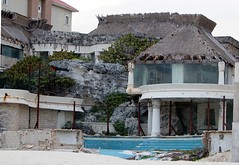 聯合國永續發展大會RIO+20將於6月底召開,一份預備在大會上發表的新報告指出,若全球氣溫比起工業化上升超過2℃兩度,到2050年之時,拉丁美洲和加勒比海地區將每年損失1000億美元。
聯合國永續發展大會RIO+20將於6月底召開,一份預備在大會上發表的新報告指出,若全球氣溫比起工業化上升超過2℃兩度,到2050年之時,拉丁美洲和加勒比海地區將每年損失1000億美元。
科學家們多以氣溫上升2℃為標準,以呼籲全球領袖穩定氣候、避免氣候變遷帶來更糟的後果。然而,報告指出,如果現在氣溫上升超過工業化前水準的2℃,將「不可避免地對經濟活動、社會運作及生態系統帶來極大的負面影響。」
這份報告由中美洲開發銀行(Inter-American Development Bank)、拉丁美洲暨加勒比海經濟委員會( Economic Commission of Latin America)、世界自然基金會(WWF)聯合撰寫。報告的初步結果5日已於華盛頓發表。
拉丁美洲和加勒比海國家的溫室氣體排放量僅占全球的11%,但這些國家卻是氣候變遷之下的「脆弱」地區。自本世紀初,這些地方的區域性國民生產毛額(GDP)有全面性的成長;同時,因為土地利用和排碳量的減少、以及能源效率的提升,其溫室氣體排放量更減少了11%。
 這些地區的脆弱性源自於對自然資源的依賴、以及易受氣候災害影響的基礎建設網路;此外,這些地區有許多生物氣候熱點, 例如亞馬遜盆地、加勒比海的珊瑚群落、沿海濕地以及脆弱的山區生態系統.
這些地區的脆弱性源自於對自然資源的依賴、以及易受氣候災害影響的基礎建設網路;此外,這些地區有許多生物氣候熱點, 例如亞馬遜盆地、加勒比海的珊瑚群落、沿海濕地以及脆弱的山區生態系統.
這份報告的標題為「拉丁美洲與加勒比海的氣候與發展挑戰:氣候韌性低碳發展下的選擇」,報告中解釋,由於地球暖化所帶來的結果,農地的減少、冰河的消失、乾旱、洪水、降雨型態的改變隨之發生,而這些也將進一步造成區域性的災害。
報告中也推斷,約在2050年前,這些地區遭受到的主要衝擊包括了加勒比海珊瑚群落的崩解、安地斯山脈海拔5000公尺以下大部分的冰河將消失、亞馬遜盆地可能發生某種程度的草原化、許多主要作物的農田消失、洪災和沿海地區遭淹沒的機會增加、熱帶性疾病的發展提高、主要盆地水文循環發生不穩定以及極端氣候事件趨於頻繁。
 報告指出,在墨西哥和巴西,緊靠海平面之上的土地分配為全球最高;因此,其受海平面上升的威脅極大。海平面每升高一公尺,將對6700公里的道路帶來影響,並造成大規模的洪災及對沿海地區的破壞。
報告指出,在墨西哥和巴西,緊靠海平面之上的土地分配為全球最高;因此,其受海平面上升的威脅極大。海平面每升高一公尺,將對6700公里的道路帶來影響,並造成大規模的洪災及對沿海地區的破壞。
這份報告的主要研究員、同時也是美洲開發銀行氣候變遷及永續發展決策領導人華特維佳樂(Walter Vergara)表示:「許多與氣候相關的變遷是不可逆轉的,甚至對災區帶來長久性的衝擊。」
維佳樂說道,「為避免進一步的破壞,適應是必要的方法,但這麼做還不夠。我們須採取大膽的行動、使排碳量曲線的上升弧度在未來幾十年減低。」
此報告也提出正面的看法:經計算之後,適應以對付衝擊的投資成本非常小,其約為自然破壞的1/10。
同時,這份報告提出建議,為避免氣候變遷的大災難可能帶來的長期影響,大量削減溫室氣體的排放量是必要的。
報告提出具體方法,在2030年前,推廣森林砍伐和其他土地利用的零淨排放量,同時致力於在2050年前消除電力及交通部門的探足跡,以將溫室氣體排放量曲線減少至人均兩噸的量,此成本為每年1100億美元。
「長期看來,」維佳樂說道:「這是一個有把握的作法,以確保拉丁美洲和加勒比海能持續在永續經營的道路上欣欣向榮。」
Latin America and the Caribbean face damages of $100 billion every year by 2050 if the global temperature rises just two degrees Celsius over pre-industrial levels, finds a new report to be released at the United Nations Rio+20 summit on sustainable development later this month.
The two degree Celsius rise is often cited by scientists as the level at which world leaders must stabilize the climate to avert the worst consequences of climate change. But a rise of two degrees C over pre-industrial levels is now seen as "unavoidable with significant negative effects in economic activities, social conditions and on ecosystems," according to the report.
Jointly produced by the Inter-American Development Bank, the Economic Commission of Latin America and the Caribbean and the World Wildlife Fund, the report's preliminary findings were presented Tuesday in Washington.
Countries in Latin America and the Caribbean are "especially vulnerable" to climate warming, although they contribute only 11 percent of the world's greenhouse gas emissions. This figure has declined 11 percent since the start of the century, a period of overall growth in regional GDP, due to reductions in land use emissions and improvements in energy efficiency.
The region's vulnerability stems from dependence on natural resources, an infrastructure network that is susceptible to climate events, and the presence of bio-climate hotspots such as the Amazon basin, the Caribbean coral biome, coastal wetlands and fragile mountain ecosystems.
Regional damages will result from diminishing agricultural yields, disappearing glaciers, flooding, droughts and changing rainfall patterns, among other events triggered by a warming planet, explains the report, "The Climate and Development Challenge for Latin America and the Caribbean: Options for Climate Resilient Low Carbon Development."
Key impacts in the region by about 2050 are projected to include partial collapse of the coral biome in the Caribbean, disappearance of most glaciers under 5,000 meters (16,400 feet) in the Andes, the likelihood of some degree of savannization 草原化 in the Amazon Basin, reduction in agricultural yields of many staple crops, increased flooding and inundation of coastal zones, increased exposure to tropical diseases, destabilization of the hydrological cycle in major basins, and the intensification of extreme weather events.
Mexico and Brazil have the largest land distribution just above sea level, making those countries vulnerable to rising sea levels. A rise of one meter (39 inches) in the sea level could affect 6,700 kilometers (4,160 miles) of roads and cause extensive flooding and coastal damage, the report projects.
"Many climate-related changes are irreversible and will continue to impact the region over the long term," said lead researcher Walter Vergara, the Inter-American Development Bank's division chief of climate change and sustainability.
"To prevent further damages, adaptation is necessary but not enough. Bolder actions are needed to bend the emissions curve in the coming decades," said Vergara.
On the positive side, the report calculates the cost of investments in adaptation to address these impacts is much smaller, about one-tenth the physical damages.
Steep cuts in global emissions of greenhouse gases are needed to avert some of the potentially catastrophic longer term consequences of climate change, the report advises.
The report identifies ways to bend the emission curve to two tons per capita, by promoting zero net emissions from deforestation and other land-use practices by 2030, combined with efforts to eliminate the carbon footprint in the power and transport sectors by 2050, at an annual cost of $110 billion.
"In the long term," said Vergara, "this is the surest way to ensure Latin America and the Caribbean continues to prosper along a sustainable path.







